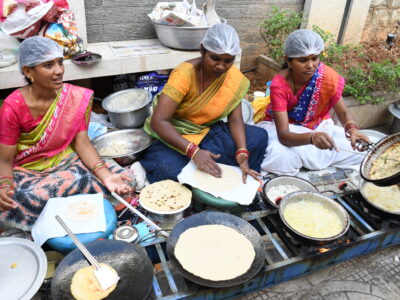
Chef Pavan
All the way from Pondicherry – the union territory known for its rich confluence of cultures, the Franco-Pondicherry menu at South Indian specialty restaurant, Dakshin in ITC Kakatiya was indeed a treat to the palate. With its heady coastal abundance, and mild French influence that just plays peek-a-boo, this regional cuisine shares much in common with the other South coastal Indian menus. So you see an increased use of coconut milk, sea food – prawns, fish etc, and deep fries and tangy, spicy and flavour-rich curries.

Meat Balls
The spice levels too are at par with the Indian standards and that is evident during the starter course itself as the masala coated and fried prawns and fish, Urla Kola Urindai – a nice spicy transformation to the otherwise harmless potato balls mixed with ginger, coriander and some masala before deep frying and again tossing it along with onion and garlic and the equally enticing meat balls tossed in oil with poppy seeds.
The foreign influence can be seen in the sea broth – made with fish, but more enticing than fishy – it is the Pondicherian version of the bouillabaisse and the use of meat stock and chicken stock for cooking in the quintessentially French way.

The Franco-Pondicherry special thalis with dishes that are so familiar, yet unique in their French influence will be on the menu at Dakshin, ITC Kakatiya till September 4, 2016
On the main course menu are the Langouste curry (mildly spiced lobster), Meen Inji Curry (ginger spiced fish curry), Yeral Vindail (Prawn curry with coconut milk and vinegar), Kothamalli Puthina Kozhi Kari (the omnipresent chicken curry made using coriander and mint that somehow exhibits a certain uniqueness of the region it is made in; The Pondi variety uses a smooth paste of the masalas with onion and garlic and the herbs as well), Kari Paccha Mulagai Asadu (green chilli spiked mutton curry), Keerai Kari (a dry preparation of local greens and that includes the fresh Amaranthus and coconut, Markari Theeyal (a tangy curry made out of drumstick, yam and raw mango cooked with spices, tamarind and coconut milk that is yet another proof that tangy curries are an integral part of the cuisine is this part of the world), the mild and flavourful Gundu Mullangai Kooru (turnips cooked with lentils and tempered with red chilli and coconut) and Vendakai Thair Curry (tempered yoghurt with spices and okra).
The desserts include the puttarisi halwa (made of wheat and rice), Semolina cake served wih rose petal basundi (now that’s what we call confluence of cultures) and the Coconut Baguette. In short this is the cuisine that will surely delight the connoisseurs of coastal flavours – vegetarian and non vegetarian both.
First published in The Hans India















